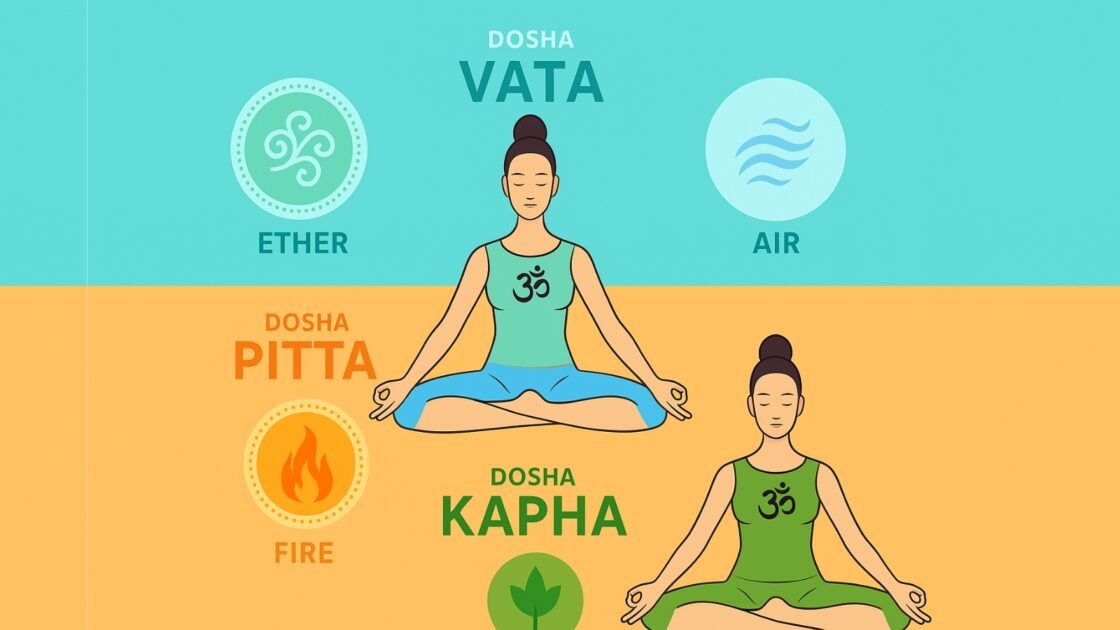
Understanding Doshas in Ayurveda: The Ancient Blueprint of Mind-Body Balance
Introduction
Ayurveda, the “science of life,” is one of the world’s oldest systems of natural healing, originating in India over 5,000 years ago. At its heart lies a profound concept that distinguishes Ayurveda from many other healing systems: the Doshas. Doshas are not simply medical jargon; they are the unique energetic forces that govern our physical, mental, and emotional tendencies. Ayurveda teaches us that by understanding our Dosha—or the blend of Doshas that make up our constitution—we can live in harmony with our natural rhythms, prevent disease, and cultivate optimal health.
The Foundations of Ayurveda
Ayurveda is not just a system of medicine—it is a philosophy of life. The word itself comes from Sanskrit: Ayur (life) and Veda (knowledge or science). Its primary aim is not only to cure disease but to promote balance, prevent illness, and support longevity. Ayurveda views the human body as a microcosm of the universe. Just as the natural world is composed of the five elements—Earth, Water, Fire, Air, and Ether—so too are we. These elements combine in specific ways to create the three Doshas: – Ether + Air → Vata – Fire + Water → Pitta – Earth + Water → Kapha
What Are Doshas in Ayurveda?
Doshas are biological energies that regulate all bodily functions—from digestion and circulation to mental processes and emotions. Every individual is born with a unique balance of Doshas, which is called their Prakriti (constitution). This balance is like your Ayurvedic fingerprint—unique and constant throughout your life. However, lifestyle choices, diet, stress, climate, and aging can disturb this balance, leading to Vikriti (imbalance or disease). In short: – Doshas are energies. – Prakriti is your natural dosha makeup. – Vikriti is your current state, which may be imbalanced.
The Three Doshas Explained
Vata Dosha: The Energy of Movement – Elements: Air + Ether – Qualities: Light, dry, cold, mobile, subtle – Governs: breathing, circulation, nervous system, elimination, creativity Traits: Slender build, dry skin, quick movements, creative, imaginative. Imbalances: Anxiety, insomnia, constipation, dry skin. Pitta Dosha: The Energy of Transformation – Elements: Fire + Water – Qualities: Hot, sharp, oily, intense – Governs: metabolism, digestion, hormones, intellect Traits: Medium build, sharp digestion, ambitious, natural leader. Imbalances: Heartburn, ulcers, rashes, anger. Kapha Dosha: The Energy of Stability – Elements: Earth + Water – Qualities: Heavy, cool, smooth, stable – Governs: structure, lubrication, immunity, memory Traits: Larger build, calm, nurturing, compassionate. Imbalances: Weight gain, congestion, depression, lethargy.

Prakriti and Vikriti
Prakriti (constitution) is the unique combination of Vata, Pitta, and Kapha you’re born with. This remains relatively stable throughout life. Vikriti (imbalance) is the current state of your doshas,
influenced by diet, lifestyle, stress, and environment. For example, a person may be Vata-Pitta by nature, but under stress and irregular meals their Vata may spike, causing anxiety and digestive issues. The goal of Ayurveda is to restore Vikriti back to Prakriti.
Signs of Dosha Imbalance
Vata imbalance: Anxiety, insomnia, constipation, dry skin, joint pain. Pitta imbalance: Anger, ulcers, skin rashes, impatience, inflammation. Kapha imbalance: Lethargy, weight gain, congestion, depression.
Balancing Each Dosha
Balancing Vata: – Lifestyle: Keep a routine, prioritize warmth, rest well. – Diet: Favor warm, moist, oily foods like soups, stews, dairy, and nuts. Avoid raw and dry foods. – Mind: Meditation, slow yoga, journaling. Balancing Pitta: Lifestyle – Stay cool, avoid overexertion, and spend time in nature. – Diet: Cooling foods such as cucumbers, melons, and leafy greens. Avoid spicy, oily foods. – Mind: Practice compassion, restorative yoga. Balancing Kapha: Lifestyle – Stay active, avoid oversleeping, and seek variety. – Diet: Favor light, spicy, dry foods such as lentils, leafy greens, and ginger. Avoid heavy, sweet foods. – Mind: Dynamic yoga, motivational practices.
Doshas and Seasons
Ayurveda connects Doshas with seasonal rhythms: – Vata: Fall to early winter (dry, cold, windy) – Pitta: Late spring to summer (hot, sharp) – Kapha: Late winter to spring (damp, heavy) Balancing your lifestyle with the season helps prevent imbalance.
Doshas and Daily Rhythms
Ayurveda also divides the day into doshic cycles: Kapha time (6–10 AM/PM): grounding, stability. – Pitta time (10–2 AM/PM): strong digestion and focus. – Vata time (2–6 AM/PM): creativity, subtle energy. Understanding this helps you align meals, work, and rest with natural rhythms.
Doshas and Personality Types
Vata personalities are visionary, artistic, and spiritual, but can be scattered. Pitta personalities are driven, ambitious leaders, but can be fiery. Kapha personalities are loyal, nurturing,and dependable, but may resist change. Knowing this helps improve relationships by recognizing temperament differences.
How to Discover Your Dosha
Ways to identify your Dosha: 1. Self-assessment quizzes available online. 2. Observation of body type, digestion, and mind tendencies. 3. Consultation with an Ayurvedic practitioner for pulse diagnosis and deep analysis.
Modern Relevance of the Dosha System
In today’s stressful and fast-paced world, Dosha knowledge is invaluable. Unlike one-size-fits-all wellness trends, Ayurveda offers personalized guidance. Instead of ‘What’s the best diet?’, the real question becomes ‘What’s the best diet for my Dosha?’ This personalization is why Ayurveda is gaining popularity in integrative medicine and wellness.
Integrating Dosha Wisdom into Daily Life
Practical steps: – For Vata: Warm oil massage (Abhyanga), regular meals, avoid overstimulation. – For Pitta: Spend time near water, practice cooling breath (Sheetali Pranayama). – For Kapha: Start the day with vigorous exercise, favor light and spicy meals, keep learning new things.
Final Thoughts
Doshas are not rigid labels but guiding principles. By observing your body and mind, you can detect imbalances early and restore harmony. Ayurveda invites you to see health as a dynamic dance with nature, where balance is the key to vitality and joy. When you align with your Dosha, life feels less like a struggle and more like a natural flow.












Leave a comment: